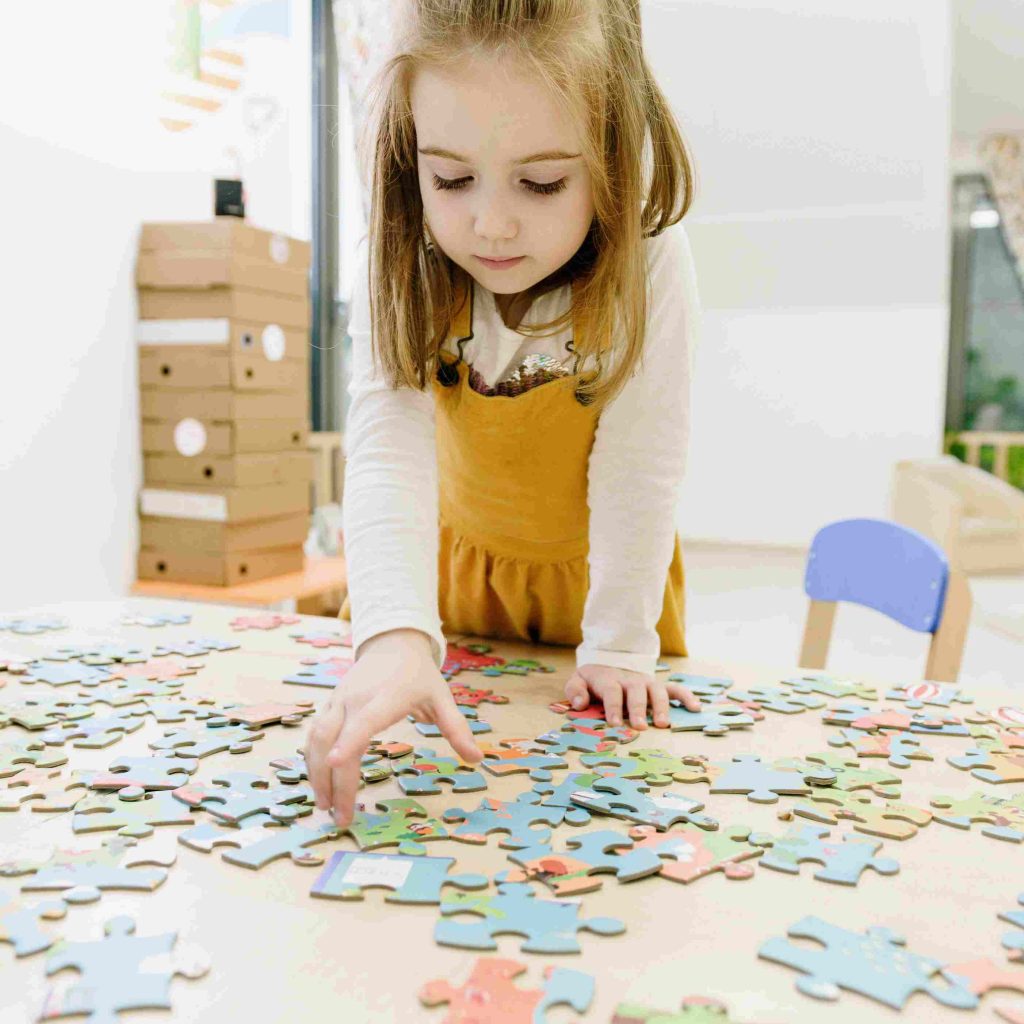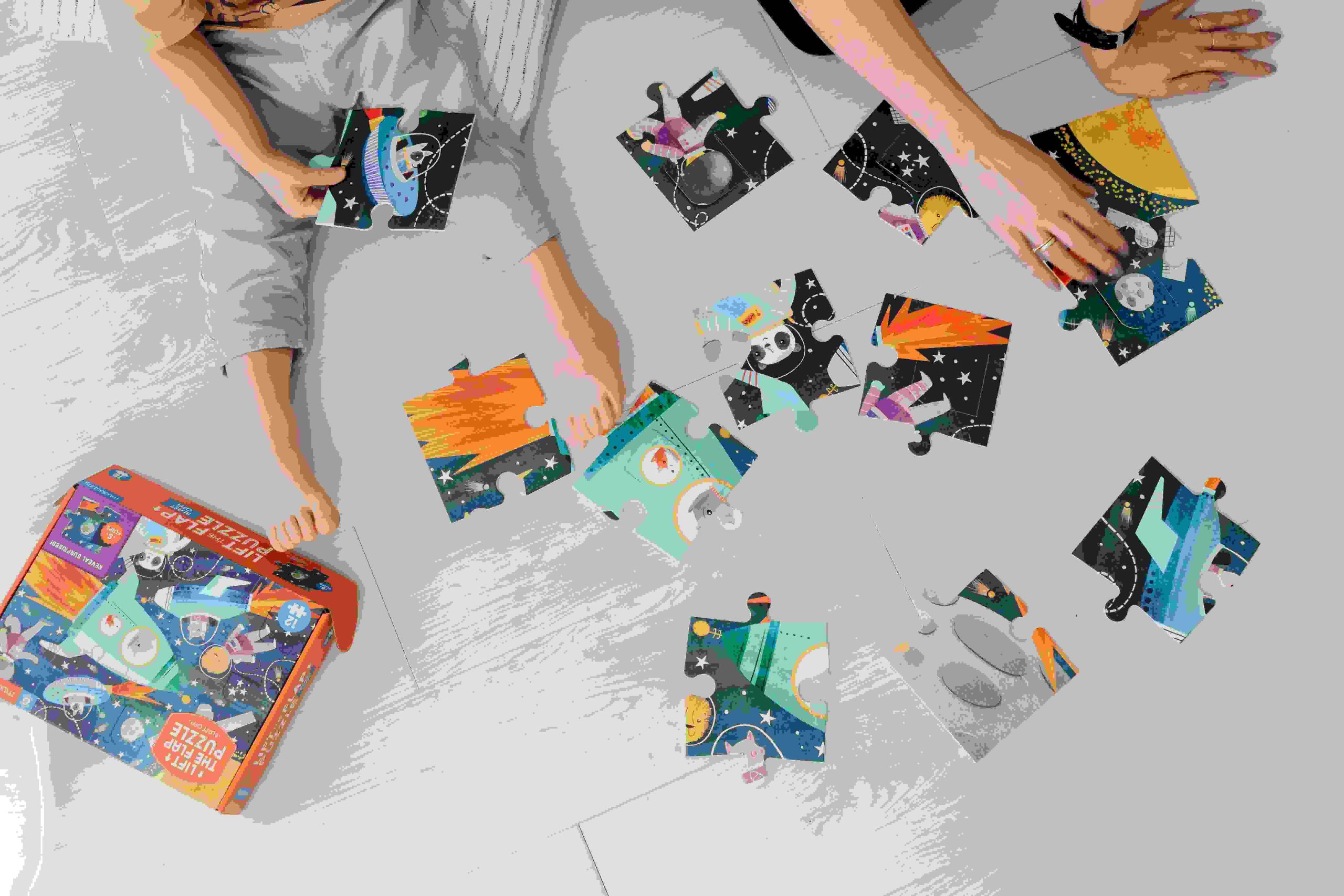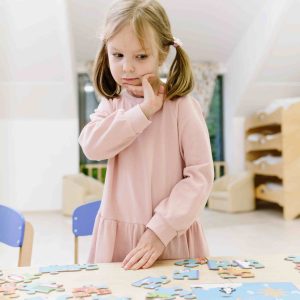Puzzles are the best way to provide fun learning experiences for kids. Simple jigsaw puzzles help children develop hand-eye coordination, perseverance, and problem-solving skills. When playing with these puzzles, children should look closely at pictures, going over them in a top-down and left-to-right pattern. It may help them notice visual similarities and differences. Left-to-right pattern. It may help them notice visual similarities and differences. The experience of completing a puzzle can also help your child to learn to accept challenges, overcome problems and deal with frustrations.
Kids can learn problem-solving, critical thinking, and organizational skills through puzzles.

KEY TAKEAWAYS:
- Pick something suitable to your child’s abilities.
- Talk with your child about the picture on the puzzle before taking the pieces out.
- Take out the puzzle pieces and place them ‘face up’.
- Find the corner and edge pieces first and put them in place.
- Look for pieces according to the shapes needed to fit a space.
- Flip and turn pieces, match colors, and look for ‘parts’ of pictures or lines that might go together.
Here is some guidance on how to help your child in the best possible way when working on a puzzle.
1. Begin with easy puzzles:
Introducing puzzles to your child should start with straightforward puzzles with small pieces. It might seem easier to let your child jump right into more intricate ones, but it’s important they feel successful by completing simple tasks first prior to taking on a more challenging puzzle.
2. Tie into Your Child’s Interests:
Parents can find puzzles that contain a subject matter that interests their child, which will motivate them to put it together.
3. Look at the Image:
As your child assembles the puzzle, ensure that they have the image of the finished product visible for reference.
4. Find the Outside Edges:
Are you an adult too who looks for the easiest places to begin on a puzzle? Take your child through the motions to find all of the pieces with a straight edge. Then, see which ones have similar colors and try to stick them together.
5. Sort the Pieces by Color:
Your child can help you sort the pieces according to their predominant color. If they are not aware of their colors yet, have them help you to find others that are similarly colored as the piece.
6. Show how the puzzle operates:
To help children learn the workings of a puzzle, understand the process, and feel successful, demonstrating the puzzle is key. Before allowing your kid to explore it freely, it’s important they have an understanding of how each part fits together. Show them gently each step so they comprehend them well.
7. Provide Help or Guidance with Words:
To ensure successful puzzle completion, provide verbal cues and emphasize one piece at a time. However, be careful not to offer too much help or check up on them too frequently; this could discourage independence, while not frequently enough monitoring progress could lead to confusion and frustration. Ultimately, remind them that they can solve it themselves!
8. Spin the Piece Around:
Even when kids discover two pieces that fit together, they sometimes give up before trying them all around. Encourage them to keep spinning and trying before giving up.
9. Simplify It:
If your little ones seem overwhelmed by too many pieces, give them a few that you know go together. Help them along by adding additional pieces that you know they’ll like.
10. Show by Example:
Before you get your child’s attention show them how you hook them together, and make sure you find matching pieces.
11. Give Positive Reinforcement:
When your child assembles their toys, praise them and have a party with clapping and dancing if it makes them smile.
12. Promote trial and error:
Trying different methods and making mistakes allows kids to become more self-reliant and confident. Positive reinforcement is important throughout any errors in order for these strategies to stick with them over the long run. It should be remembered that patience and persistence are often required before success occurs, especially when it comes to younger learners.
13. Come up with new and creative ideas and accept new challenges:
Puzzles provide a great way to challenge yourself and are easy to repeat with just re-arranging or exploring new ideas. Add elements such as color, numbers, and logic to increase the difficulty and create bigger rewards for success. Repetition helps refine motor movements and problem-solving skills and increases the enjoyment of the game!
Bonus:
If you want to teach your kids: how to solve challenging math problems so quickly, you may check out this amazing content https://bloggchain.com/kids-math-solving-challenging-10x-faster/
14. Run a Puzzle Competition to See Who’s Faster:
Competition challenges are motivating for children because they get the chance to prove their abilities and Skills as a parent you can take advantage of this to make your child work hard and refine their skills while playing puzzles. Simply hold a contest between your family members where the winner is the one that assembled their puzzle the fastest. This works well if you have more than one kid so they can compete with each other more closely.
15. Make the Existing Puzzles More Challenging:
It is a good idea to make it slightly challenging for the child to assemble the puzzles. Some ways to accomplish this may include:
- Asking him to complete the puzzle without looking at the reference image.
- Setting up a timer and telling the kid to finish the puzzle faster.
- Letting him work on the puzzle after you remove a piece or two.
Summary:
Now you have some great tips to effectively teach your child how to solve puzzles. You don’t have to use them all; instead, just choose the ones that work best for you and your kid. These tips will help develop the kid’s problem-solving skills and motivate them to play with puzzles without getting bored.
If the list above seems to be long for you, then focus on the following five which are probably the most important:
- Begin with easy puzzles (#1)
- Provide Help or Guidance with Words (#7)
- Promote trial and error (#12)
- Run a Puzzle Competition to See Who’s Faster (#14)
- Make the existing puzzles more challenging (#15)
Sponsored by:
If you want to grow your blogging or any online business, you can go and contact https://elonmusktrillion.com/ for the best digital marketing services ever at a cheaper price.


Pingback: A Step-by-Step Guide to Teaching Children How to Draw Nicely (5 Pro Tips & Tricks) - Bloggchain
Pingback: Top 10 New Puzzles for Kids to Solve - Bloggchain